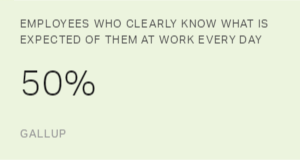Story Highlights
- The right outcomes promote customer engagement
- Outcomes need to align with purpose and strategy
- Hiring for talent is the heart of an outcome-based culture
Leaders in outcome-based cultures (OBCs) are able to concentrate on what people achieve -- the outcome -- not necessarily how they achieve it.
While cultures like these aren't formal business structures, they do require structured leadership input, especially regarding selection and engagement -- they put the right people with the right talents in the right roles and then drive their performance through engagement. OBC leaders and managers don't micromanage. They guide their employees' performance and contributions to overall strategies.
Outcomes differ across companies, teams and, to some extent, projects. Overall, outcomes should align with the organization's purpose and brand promise. But even between these two guardrails, outcomes need to be clearly defined and explained.
It is essential for employees to have clear, attainable outcomes -- because no matter how talented workers may be, they can't do their jobs without a clear picture of what success looks like.
To get the right outcome every time, leaders should consider the demands of your customer, your workers and your organization's purpose.
Your Customers
An outcome is only right if it's right for your customer. Don't know if it's right? Ask.
Customers are the ultimate judges of your performance. Their verdict is in their loyalty and spending, which can be explained and predicted by their level of engagement. That verdict can be immensely lucrative, too.
Customers who are fully engaged in a business-to-customer relationship represent a 23% premium in share of wallet, profitability, revenue and relationship growth over the average customer. Business-to-business companies with engaged customers have an average 63% lower customer attrition, 55% higher share of wallet and 50% higher productivity.
When leaders are defining outcomes, they must remember that they can affect customer engagement -- for better or worse -- depending on how they approach their customers.
Your Purpose
An organization's purpose is pretty much a constant. But strategies for fulfilling that purpose change to fit the environment and can vary by role and goal. This makes it essential to define outcomes that are clear and congruent with both purpose and strategy.
The Walt Disney Company offers a good example.
Disney seeks to "develop the most creative, innovative and profitable entertainment experiences and related products in the world." The company's different functions have unique strategies to do that: The film division works through movies, the theme parks through experience and retail with products.
Each function has departments within them that have strategies of their own. The people who design princess wands for retail sale, for instance, place even the sparkles on wands with a view toward innovation, creativity and profit.
The people who maintain the roller coasters keep Disney innovative, creative and profitable by never, ever letting a guest be unsafe.
Regardless of the function or department, all of Disney's outcomes are clearly defined and support the strategies that align with the purpose.
Your People
After identifying the right outcome, leaders need to decide how people should attain it. They can choose to take command-and-control approaches that dictate every step. This may help leaders feel that the process is well-regulated, but these kinds of approaches don't guarantee the outcome. What's more -- they may foster disengagement and resentment.
OBC leaders don't seek that rather dubious assurance. They place their confidence in their people. And if they hire for talent, their confidence is often well-placed.
In fact, hiring for talent is the only way to run a successful OBC. In an outcome-focused environment, employees are free to achieve outcomes using methods that spring from their own innate capacities -- their talents. OBC leaders must know what those capacities are so they can determine fit to role. And determining fit to role takes analysis.
For example, a call center director decides that the right outcome is increased sales. She could reward the people who keep their calls short and aggressive and direct everyone else to emulate them, leading to more calls in a shift and, theoretically, more sales via an increased contact rate. Many call center directors would likely take this approach.
But she doesn't. Her salespeople have different talents that they use in different ways to reach the same outcome: sales. So, instead of dictating a one-size-fits-all mandate about call length, she adopts talent-focused solutions.
She closely assesses the job-related characteristics of all her people and helps them develop their talents into strengths that sell.
She also determines what makes her top sellers different from the others. The performance-specific tendencies she finds in them are the ones she looks for in future job candidates, and she begins to hire people who demonstrate similar patterns of thought, feeling and behavior.
This reflects Gallup's analytics-based hiring approach. The results of an analysis using this approach show how the right capacities for the role aren't always what we think, and they're not always overt, either.
But the outcome-focused results of hiring for talent, Gallup studies show, are noticeable. Companies that hire from the top 20% of candidates -- based on assessing their talents with our validated selection instrument, naturally -- see 10% higher productivity, a 20% increase in sales, 30% higher profitability and 10% lower turnover.
Cultural Commitment
Although OBCs may seem a little laissez-faire to the casual or less informed observer, they actually require sustained cultural commitment to well-defined, well-understood outcomes.
This culture and its hyper-focus on results is what enables people to achieve outcomes with little oversight.
Of course, all companies should define outcomes, engage customers, live by their purpose and cast talent to job role properly. But OBCs depend on it -- consistently considering their customer engagement, purpose and people to get the right outcomes is the organizing principle of the whole culture.
The operational piece of this culture is the manager -- the one who coaches individual performance to align with strategy and purpose to reach the well-defined outcomes. Gallup's research shows how the best managers in the world do it, as discussed in the next article of this series.
Learn more about how Gallup can help your organization shift to a culture of performance development:
- Register your managers for an upcoming Leading High-Performance Teams course to give them the tools and techniques they need to inspire greater performance.
- Discover how to use the CliftonStrengths assessment to coach your teams to great outcomes.
- Inquire about our performance management solutions, ranging from process redesign to manager training, designed to further your growth and development strategy.



